To get rid of roaches in your apartment, start with thorough sanitation. Clean surfaces regularly, seal food in airtight containers, and empty trash frequently. Next, inspect for cracks and gaps; seal them up to prevent entry. Consider natural remedies like diatomaceous earth or essential oils, or use targeted chemical treatments if needed. Set sticky traps in areas of high activity to monitor the infestation. Keep your space tidy and eliminate clutter to reduce hiding spots. These steps can significantly help control roaches. For a more comprehensive approach to pest control, you'll discover helpful strategies.
Key Takeaways
- Maintain a regular cleaning schedule to eliminate food debris and moisture that attract roaches.
- Seal cracks and gaps around doors, windows, and pipes to prevent entry points for roaches.
- Use targeted insecticides like gel baits and sprays in roach habitats for effective control.
- Implement natural remedies such as diatomaceous earth and essential oils to deter and reduce roach populations.
- Seek professional pest control assistance if infestations persist or are severe for long-term solutions.
Sanitation and Cleaning

To effectively combat roaches in your apartment, maintaining high levels of cleanliness is crucial.
Establish a regular cleaning schedule for common areas like hallways and staircases. Sweep, vacuum, and mop often to eliminate potential food sources. Roaches are omnivorous and will feed on a variety of materials, making cleanliness essential.
In the kitchen, clean countertops, sinks, and stovetops after each use to get rid of spills. Don't forget to clean the refrigerator regularly and discard expired items.
Manage garbage by using sealed bags and emptying trash bins frequently. Store pet food in airtight containers and promptly clean up any spills.
Sealing Entry Points
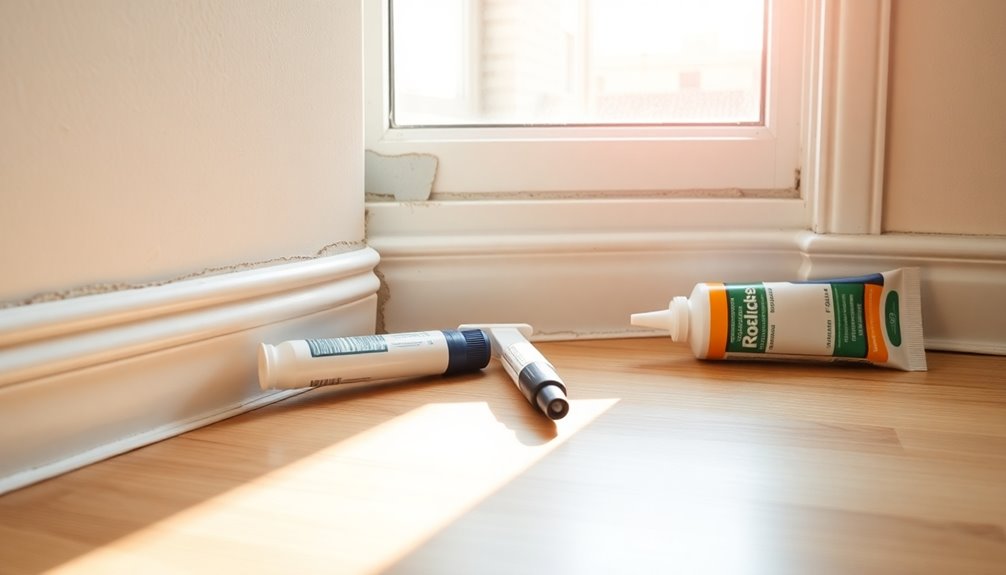
Sealing entry points is a crucial step in preventing roaches from invading your apartment. Start by inspecting your space for any cracks and gaps around doors, windows, baseboards, and pipes. Don't forget to check for moisture leaks, as these can attract roaches. Use caulk to seal identified cracks and gaps, and foam for vents and pipes. Plug any holes in walls, floors, or ceilings to create a barrier. Regularly inspect your apartment to catch new entry points early. Additionally, addressing water access issues by fixing leaks can significantly deter roaches. Also, inspect items entering your home for pests, keep clutter to a minimum, and dispose of cardboard or paper products.
Natural Remedies
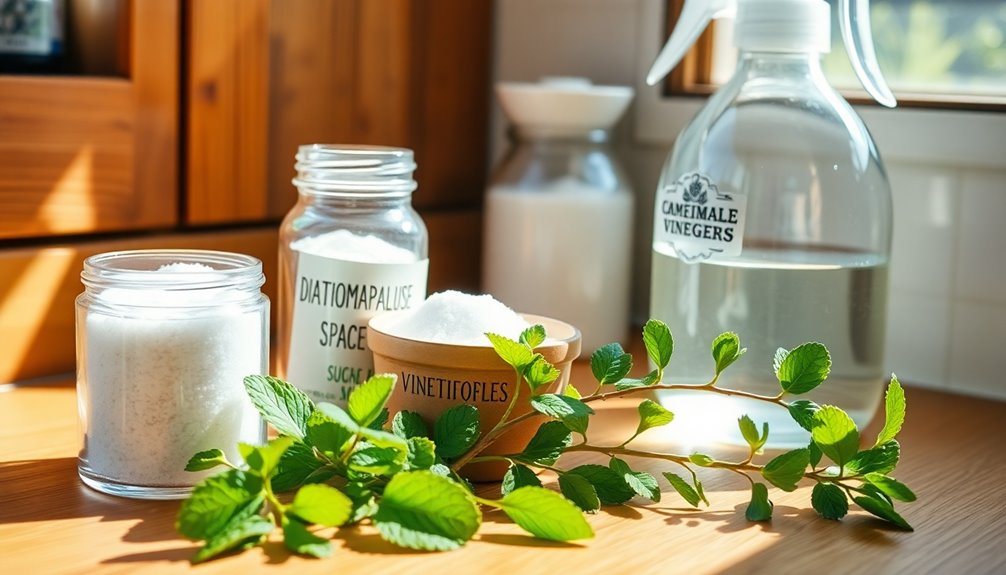
After securing entry points, you can enhance your roach control efforts with natural remedies that are safe and effective.
Start with diatomaceous earth; sprinkle it in cracks and under sinks to dehydrate roaches. It's non-toxic and safe for kids and pets, but be patient—it may take up to two weeks to see results. Regular vacuuming is crucial for controlling German cockroach populations as it removes food particles and droppings, helping to limit adult reproduction.
Essential oils like tea tree and peppermint can also repel roaches. Mix a few drops with water in a spray bottle and target areas where roaches hide.
For an easy option, scatter crushed bay leaves in pantries; while they won't kill roaches, they'll deter them.
Lastly, consider boric acid mixed with sugar for bait stations, but keep it out of reach of children and pets.
Chemical Treatments
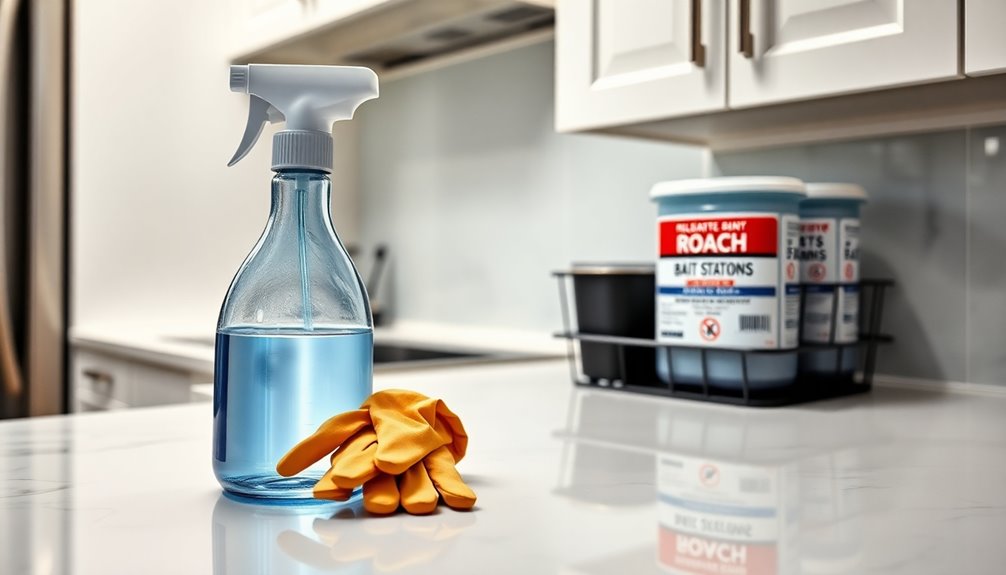
While natural remedies can be effective, sometimes you need a more aggressive approach to tackle a roach infestation in your apartment.
Start by identifying the right insecticide based on the severity of your infestation and the specific type of roaches. Options include gel baits, sprays, and dusts, each with varying effectiveness. Cockroaches are known to thrive in warm, humid environments, which can make them more challenging to eliminate.
When using sprays, apply them in cracks and crevices for targeted action, ensuring proper ventilation during application. For dusts like boric acid, apply lightly in roach travel areas.
Always read and follow the label instructions carefully, and monitor the effectiveness of your chosen method.
If the problem persists, don't hesitate to seek professional assistance for a comprehensive treatment plan and long-term prevention strategies.
Traps and Monitoring

When battling a roach infestation, utilizing traps and monitoring techniques can significantly enhance your efforts.
Start by using sticky traps, which are safe around kids and pets, placing them along baseboards and near entry points. You can also create homemade traps with items like jars, petroleum jelly, and sugar. Gel baits are effective for hard-to-reach areas; just apply small dots in cracks where roaches hide. Additionally, ensuring that you maintain good sanitation practices can help reduce the number of roaches attracted to your traps.
For effective placement, position traps near food and water sources, and check them daily to monitor infestation levels. Additionally, it’s important to ensure that the traps are strategically placed along common pathways that pests may frequent. Keep in mind that in areas like spas, incorporating spa floor plan essentials can help in designing a layout that minimizes pest accessibility while maintaining a serene environment for clients. Regular maintenance and monitoring not only reduce pest populations but also enhance the overall hygiene and ambiance of the space.
Conduct visual inspections in dark areas, and consider night watch inspections to catch roaches in action. Regularly replace traps to maintain effectiveness, and you'll gain valuable insight into the roach population in your apartment.
Professional Extermination

If you're overwhelmed by a roach infestation in your apartment, seeking professional extermination can be a game-changer.
Exterminators start with a thorough inspection to assess the severity and pinpoint entry points, ensuring they tailor their treatment effectively. They may use gel bait insecticides, boric acid, or even fumigation for severe cases, all designed to target roaches at different life stages. For effective treatment, a minimum of two visits is typically required, especially for more serious infestations.
After treatment, they'll seal entry points and recommend maintenance plans to keep your space roach-free.
Follow-up visits help ensure the treatment's success, and you'll receive valuable advice on preventing future infestations.
Identifying Roach Species

Identifying the specific species of roaches in your apartment is crucial for effective pest control.
You might encounter the American cockroach, which is reddish-brown, about 1 to 1.5 inches long, and commonly hides in dark, damp areas. This species can carry diseases and contaminate food, posing health risks.
German cockroaches are smaller, around 5/8 to 2/3 inch, tan to light brown, and prefer kitchens.
If you see a shiny, reddish-brown cockroach up to 1 inch long, it's likely an Oriental cockroach, often found in sewers.
Lastly, the Brown-Banded cockroach is about 1/2 inch long, with distinct banding and a preference for warm, dry spots.
Knowing these details helps you tackle the right species effectively, ensuring a more targeted pest control approach.
Preventing Future Infestations
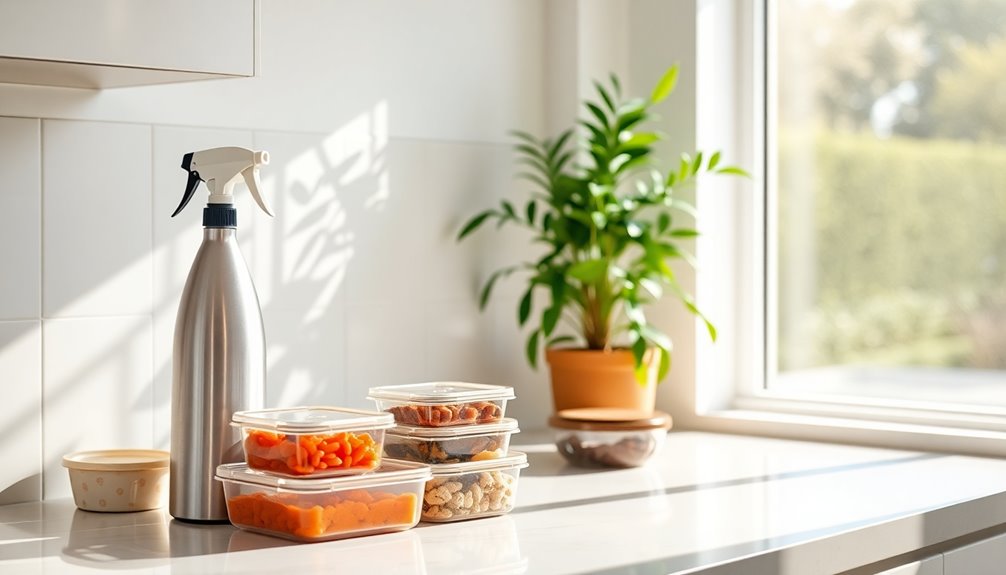
After pinpointing the type of roaches infesting your apartment, taking proactive steps to prevent future infestations is vital.
Start by maintaining cleanliness—sweep, mop, and vacuum regularly, take out the trash daily, and store food in sealed containers.
Don't forget to clean your pet's food and water bowls, and wash dishes promptly.
Next, eliminate moisture by fixing leaks and ensuring good ventilation.
Store items in dry areas and check appliances for moisture buildup.
Seal entry points by caulking cracks, using weatherstripping, and installing door sweeps.
Lastly, consider natural deterrents like essential oils, herbs, and baking soda to repel roaches. Additionally, be aware that certain toxic plants can pose risks to pets, which may lead to unintentional food sources for roaches.
Understanding Roach Behavior

Understanding roach behavior is crucial for effective pest control, as their habits and social structures significantly influence how infestations occur.
Roaches, typically brown or black, range from 0.5 to 2 inches long and are mostly nocturnal, hiding during the day and scavenging for food at night. They've an omnivorous diet, thriving on food debris and organic matter found in warm, humid environments like kitchens or bathrooms. Their flat, oval body structure allows them to easily hide in narrow cracks and crevices, making them difficult to spot.
Their gregarious nature means they often gather in groups, following pheromone trails to food sources. Constant grooming helps them maintain hygiene and detect danger.
Emergency Measures
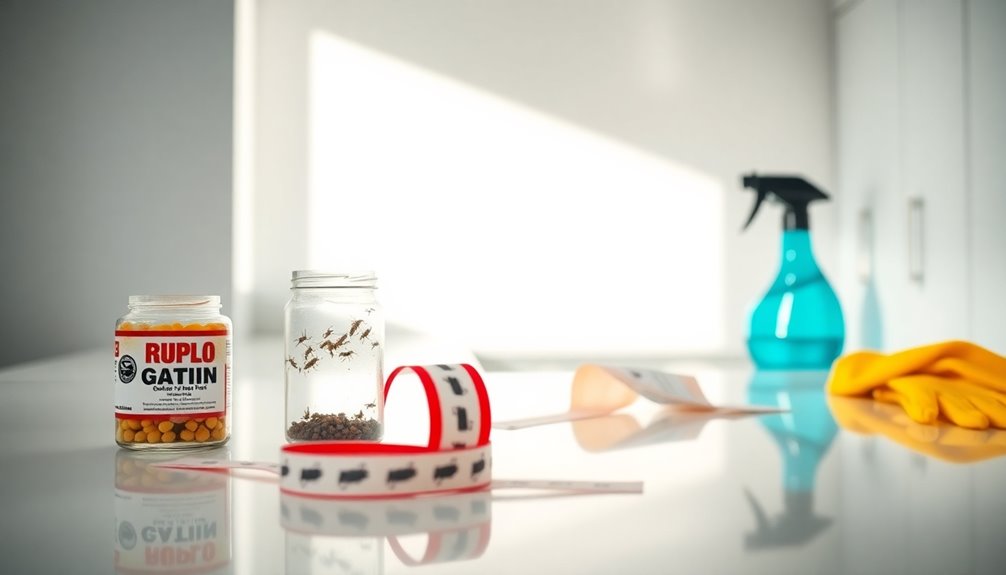
When faced with a roach infestation, taking immediate action can make all the difference in regaining control of your apartment.
Start by sealing all entry points with caulk and cleaning up clutter that roaches can hide in. Fix any leaks to eliminate moisture, and set sticky traps in active areas.
If the situation worsens, don't hesitate to call a professional. For chemical control, apply insecticides in roach habitats and spray the perimeter to deter re-infestation.
Consider using natural remedies like boric acid or diatomaceous earth for added defense. Regular cleaning and maintaining a low humidity environment will help keep your space roach-free.
Act quickly to protect your home from these unwelcome pests!
Frequently Asked Questions
What Attracts Roaches to Apartments in the First Place?
Roaches are attracted to apartments for several reasons.
You might leave crumbs or spills on surfaces, which draws them in. Unsealed pet food and dirty dishes also create a feast for these pests.
High humidity and standing water in your home can provide the moisture they crave.
Cluttered spaces and unemptied trash cans offer hidden havens, while poor hygiene practices can further entice them to invade your living space.
How Long Can Roaches Survive Without Food and Water?
Roaches can survive without food and water for up to two weeks, depending on their species and environmental conditions.
Factors like temperature and humidity play a crucial role in their survival.
You'll find that some roaches conserve water by reducing their activity or entering a dormancy state.
Are Roaches Harmful to My Health?
Yes, roaches can be harmful to your health. They carry allergens that can trigger asthma and allergies, leading to respiratory issues.
You might also face bacterial contamination from roach waste, increasing the risk of foodborne illnesses. Additionally, chronic exposure to these pests can weaken your immune system and contribute to psychological stress.
It's essential to address any roach infestations promptly to protect your health and overall well-being.
Can Pets Be Affected by Roach Treatments?
Yes, your pets can be affected by roach treatments.
Insecticides and bait traps often contain toxic substances that can harm them if ingested or if they come into contact with treated areas.
It's crucial to keep your pets away from these areas until it's safe.
Always read labels carefully and consider using pet-safe products.
If you notice any unusual symptoms in your pets after treatment, consult your veterinarian immediately for advice and care.
How Can I Tell if My Neighbor Has a Roach Problem?
If your neighbor's place feels like a haunted house, filled with creeping shadows, you might suspect a roach problem.
Keep an eye out for live roaches in their kitchen or bathroom, and check for egg shells and droppings around common areas.
If you catch whiffs of unpleasant odors or hear scuttling noises at night, it's a sign.
Dirty conditions or pest control activity can also hint that roaches have invaded their space.
Conclusion
In your battle against roaches, think of your home as a fortress, a sanctuary that deserves protection. By embracing cleanliness, sealing off entry points, and using effective treatments, you're not just fighting pests; you're reclaiming your space. Each step you take symbolizes your resilience and determination to create a safe haven for yourself and your loved ones. Stay vigilant, and remember that a little effort today can turn your fortress into an impenetrable stronghold tomorrow.









